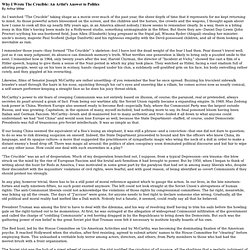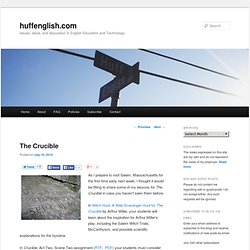

Why I Wrote The Crucible: An Artist's Answer to Politics. Why I Wrote The Crucible: An Artist's Answer to Politics By Arthur Miller As I watched "The Crucible" taking shape as a movie over much of the past year, the sheer depth of time that it represents for me kept returning to mind.

As those powerful actors blossomed on the screen, and the children and the horses, the crowds and the wagons, I thought again about how I came to cook all this up nearly fifty years ago, in an America almost nobody I know seems to remember clearly. In a way, there is a biting irony in this film's having been made by a Hollywood studio, something unimaginable in the fifties. But there they are--Daniel Day-Lewis (John Proctor) scything his sea-bordered field, Joan Allen (Elizabeth) lying pregnant in the frigid jail, Winona Ryder (Abigail) stealing her minister-uncle's money, majestic Paul Scofield (Judge Danforth) and his righteous empathy with the Devil-possessed children, and all of them looking as inevitable as rain.
"The Crucible" was an act of desperation. Lessonplan. Newsltr. Every Witch Way: Learning From the Infamous Trials of Salem. Check out these resources for teaching about this dark chapter in America's past.

The Salem witch trials offer rich fodder for social studies lessons. The following Web sites offer ideas for using the events as a springboard for discussing seventeenth-century society, women's roles, tolerance, justice, and more: Salem Witch Trials Unit This unit for fifth graders presents a synopsis of the events, two dozen simple activities, and a bibliography for teachers and students. The Crucible. As I prepare to visit Salem, Massachusetts for the first time early next week, I thought it would be fitting to share some of my lessons for The Crucible in case you haven’t seen them before.

In Witch Hunt: A Web Scavenger Hunt for The Crucible by Arthur Miller, your students will learn about the inspiration for Arthur Miller’s play, including the Salem Witch Trials, McCarthyism, and possible scientific explanations for the hysteria. In Crucible, Act Two, Scene Two assignment (RTF, PDF) your students must consider whether Act Two, Scene Two, added by Miller later on, is materially necessary to the play. Some argue that it changes Abigail’s motives from desire for John Proctor to madness. In “Half-Hanged Mary” by Margaret Atwood (RTF, PDF—credit Jana Edwards) students read a poem based on the true story of Mary Webster, accused of witchcraft in the 1680′s. It would make a good introduction or companion to The Crucible.
I most likely will not be posting next week while I am on vacation. Witch Hunt: A Web Scavenger Hunt for The Crucible. Follow the directions given for each section.

Answer thoroughly in complete sentences on your own paper. Do not "cut and paste" -- rephrase the answers in your own words. "Participate" in the Salem Witch Trials. Write a paragraph response, as the accused, describing your feelings. What are the main differences between the historical witch trials and The Crucible? This scavenger hunt was written by Dana Huff and is licensed under a Creative Commons License.
Petitions of Witches Awaiting Execution in Salem. Biographies of Key Figures in the Salem Witchcraft Trials. About.com: Chronology of Events Relating to the Salem Witchcraft Trial of 1692. SECRETS OF THE DEAD . The Witches Curse. The trouble in Salem began during the cold, dark Massachusetts winter, in January of 1692. Eight young girls began to take ill, begining with 9-year-old Elizabeth Parris, the daughter of Reverend Samuel Parris, and his niece, 11-year-old Abigail Williams. But theirs was a strange sickness: the girls suffered from delirium, violent convulsions, incomprehensible speech, trance-like states, and odd skin sensations. The worried villagers searched desperately for an explanation. Their conclusion: the girls were under a spell, bewitched -- and, worse yet, by members of their own pious community.
And then the finger pointing began.